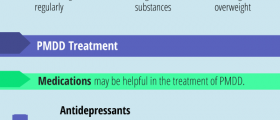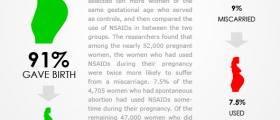Headaches during periods are a common complaint. A good clinical history is essential to differentiate between possible causes. From a long list of possible causes, premenstrual syndrome and migraine are the two most commonly encountered conditions at the office.
Premenstrual syndrome
Around 10% of women experience severe premenstrual symptoms. Although the exact mechanism of premenstrual syndrome is unknown, female sex hormones, related chemicals and their cyclical monthly changes offer reasonable explanations to most of the symptoms.

Prostaglandins produced in abundance during menstrual cycle cause cerebral vasodilatation. Prostaglandins also reduce the cerebral pain threshold so some women feel more pain during menstruation.
Female sex hormones directly control the synthesis of prostaglandin and other similar chemical mediators. In women who are susceptible (those who have an increased tendency of blood clotting) may get cerebral venous sinus thrombosis during periods.
Further investigation is rarely needed. Particularly worrisome and severe symptoms may prompt investigation, but often no abnormality is detected. Pain killers can relieve many premenstrual symptoms. Aspirin, Mefenamic acid, and acetaminophen are a few commonly prescribed pain killers.
Migraine
Migraine is characterized as a chronic headache associated with autonomic nervous system symptoms. The underlying mechanism of migraine is unknown.
A genetic predisposition is seen because migraine has a familial trend. Certain drugs, tea, coffee, chocolate, oral contraceptive pills and menstrual cycles tend to trigger episodes of migraine.
Migraine comes in four phases. The prodromal phase is a premonition phase where symptoms such as altered mood, anxiety, irritability, craving, stiff joints and muscles warn the patient. This prodromal phase may last from just two hours to a few days.
An aura occurs just before the onset of the actual headache. Sensory symptoms are most common by far. Pins and needles, spinning and hallucinations are a few examples.
The pain phase can have variable duration and frequency. Postdrome is a variable time period after the acute attack during which the effects slowly fade away. Topiramate, sodium valproate, metoprolol are effective first line drugs against migraine. Patients respond to treatment differently and thus migraine has a highly variable prognosis.
Sinusitis
Sinusitis sometimes seems to flare up during periods.
This may be due to an increase in local responsiveness to irritants. Chemicals such as prostaglandins are inflammatory mediators. Many of these mediators are synthesized by inflamed tissues in response to an injurious agent.
During menstruation, there is an increase in the synthesis of these chemicals. When the systemic supply of mediators adds up to the local production, the result is an exaggerated inflammatory response. Inhibitors of prostaglandin synthesis can therefore be used to counter this effect.
Non-steroidal anti-inflammatory drugs and cyclooxygenase inhibitors are very effective against prostaglandin-mediated clinical conditions.
- Lay CL, Broner SW (May 2009). "Migraine in women". Neurologic Clinics 27 (2):503-11
- Shamliyan TA, Choi JY, Ramakrishnan R, Miller JB, Wang SY, Taylor FR et al. (2013)."Preventive pharmacologic treatments for episodic migraine in adults.". J Gen Intern Med 28 (9):1225-37.
- Photo courtesy of SteadyHealth















